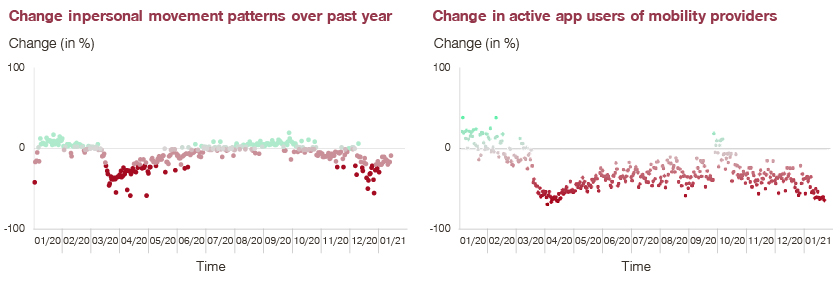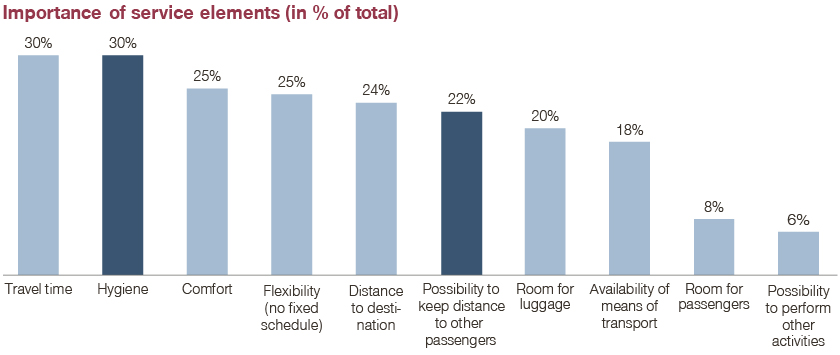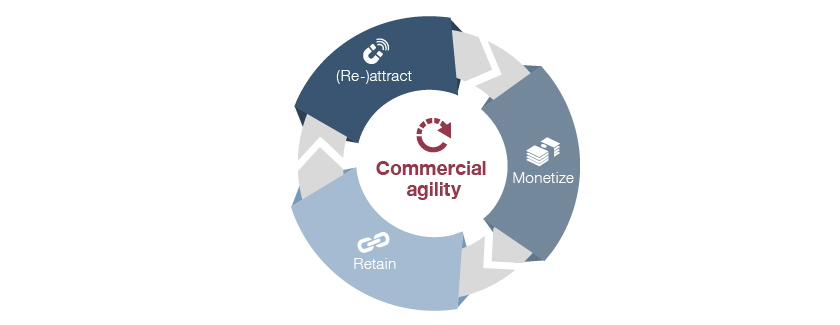The crisis has triggered monumental changes in travel behavior, and players in the mobility sector are among the hardest hit. But all hope is not yet lost. As demand begins to return in some markets, companies need to get creative in order to re-attract, monetize, and retain customers. Here are our recommendations on how mobility players can drive growth in 2021 and beyond.
Prior to the COVID-19 crisis, the mobility revolution was already underway. Global trends transforming the future of mobility included urbanization and reallocation of space in cities, less ownership, a greater sharing affinity, and a growing popularity of subscriptions. Meanwhile, more and more vehicles became digital and electric against a backdrop of growing ecological awareness and a desire among consumers for greener transport alternatives.
These trends led to a spike in venture capital for the mobility sector, which in turn spurred strong growth and a positive outlook for the coming years. A PitchBook report showed that in Quarter 1 of 2020, venture capitalists spent $11.8 billion US dollars on mobility companies, representing a 62 percent increase year-on-year.
We had already seen streaming services like Netflix transform how media is consumed. Then transportation reached a similar crossroads, with interest in mobility as a service (MaaS) growing in cities around the world. Mobility forms included bikes and scooters from startups like Mobike, Lime, and Tier. We saw the success of ride-hailing apps like Uber, ride-sharing apps like BerlKönig, and car-sharing apps, e.g. from traditional rental companies like SIXT. Customer-centricity in mobility was set to be one of the biggest trends of the 2020s. Nobody could have foreseen the COVID-19 pandemic and the resulting government restrictions on population movement.
The mobility landscape in 2021 and beyond
It’s challenging for mobility providers to deliver a customer-centric proposition when public life has grinded to a halt. As expected, there has been a significant reduction in overall mobility and active usage of mobility apps, with statistics from Germany showing a drop of more than 50 percent. Even more concerning, however, is that although movement patterns in Europe temporarily recovered as some restrictions were lifted during the summer of 2020, usage of mobile mobility apps did not.

On top of that, a recent Simon-Kucher study shows that 20 percent of consumers expect to use on-demand mobility services far less for everyday transport than they did prior to the pandemic, highlighting the uncertainty about mobility tech solutions and increased competitive pressure for mobility providers in a post-pandemic world.
The bad news was confirmed by the mobility market’s steep drop in revenues in 2020, severely disrupting the once positive growth outlooks for the industry.
But: reactivation of users signals recovery for the mobility industry
On a positive note, users have not abandoned their mobility apps completely. The majority of consumers have stayed registered on their apps and can be reactivated as mobility levels go back up again.
An indication that this is working can be seen in the latest figures from Uber, showing that bookings are on their way back up, especially in countries like Taiwan, New Zealand, and Australia where movement restrictions have been eased. This increase in demand provides a ray of hope for mobility providers in countries with lighter movement restrictions.
There has been a lot of talk about “the new normal” in the context of COVID-19. Independent of how quickly demand returns, players must also prepare for the “new customer”. Our study shows that customers now place high value on certain elements of travel that may not have been as important prior to the pandemic. For example, hygiene will play one of the most important roles for customers when deciding on a means of transportation. Adapting quickly to changes in customer preferences will be key for mobility players as demand returns.

Commercial creativity will be the key to enabling recovery and driving growth in mobility
Before COVID-19, many companies had the time and resources to find the perfect solutions to critical challenges. Innovation processes followed a step-by-step method of “hypothesize on the best approach, research, optimize, and launch”. But today, companies need agility to react, learn, and adjust in a dynamic environment. They need to act quickly in order to learn quickly, and here perfection is achieved through continuous refinement. They need creative commercial operations.
In a recent Simon-Kucher paper addressing the challenges of the demand revolution, commercial creativity is defined as “the ability to re-engineer every cylinder of the revenue engine”. What this looks like in practice will differ by industry and company, depending on how heavily they are affected by changes in demand and how commercially creative they were to begin with. We have identified three key areas where mobility players need to be especially creative in their commercial activities:
Commercial creativity for mobility players
- (Re)attract customers
While it cannot be denied that mobility players will need to work hard to attract new customers during and beyond the pandemic, there are several key mechanisms and initiatives that companies can use to drive (re)attraction of demand. One effective measure is identifying the regions and stages within the conversion funnel that are underperforming and then triggering initiatives to attract and activate customers in those areas. This could be in the form of a promotion to reward existing customers, such as offering discounts on a customer’s first journey after lockdown, or to attract new customers, such as offering 30 free minutes of travel for completing their user profile.
For many players, the conversion funnel is a challenge. Several players have prevailed by developing a dynamic trigger model based on relevant KPIs. Such a model delivers real-time insights into customer performance during the entire lifecycle so that outliers can be quickly detected by organizations, who are supported by a dedicated playbook containing countermeasures (e.g. promotions, personalized notifications, etc.) for any given scenario. - Successfully monetize
Mobility players have to consider several crucial factors when it comes to designing and monetizing their services. Customer preferences regarding mobility may vary situationally, e.g. a user on their morning commute to work or traveling for a business trip will likely have a strong need for convenience but a low price sensitivity. Here it may make most sense to offer a premium car nearby, available within two minutes and at a higher price point. The same user taking a weekend trip on a Friday evening may have a higher price sensitivity but lower convenience needs. Here a larger vehicle with space for luggage is likely the best option, available at a lower price but with a longer waiting time and located further away.
Then there is the question of what price model and metric to apply. Do you charge by kilometer or by hours or minutes? Do customers make a one-time payment, a subscription, or a two-part tariff? This decision will also play a huge role in enabling certain use cases and catering to a wide range of customer needs, while helping providers to balance supply and demand and drive vehicle utilization.
Our experience the mobility sector has shown that dynamic offer models can be a strong differentiator. Several mobility players have monetized a variety of different use cases by adjusting their product, price, and communication to situationally changing customer preferences or shifting demand profiles. Retain customers
Throughout the COVID-19 crisis, we at Simon-Kucher have emphasized that building a resilient business requires an orientation toward both customer loyalty and profits. This means that a company is able to generate more and more income from the same group of customers over several years. Think about how often a Prime subscriber will order from Amazon in order to get the most out of their subscription, or how often an Uber customer in the US checks their Uber Rewards points to see how many more trips they need to make to progress toward the next tier?
Service providers can increase usage and keep customers in their service ecosystem by optimizing three key levers: Subscriptions, rewards programs, and customer-base promotions.![graph]()
Commercial agility: how Simon-Kucher can help
A commercially creative organization puts business intelligence at the core of its strategy. But picking up trends from both internal and external data is not sufficient on its own. It will take a combination of commercial creativity and commercial agility to pick up the right cues and adjust the go-to-market model quickly and effectively.
Best-in-class companies have developed new capabilities during the crisis. They are much more prepared by planning for extreme scenarios with “off-the-shelf” action plans, rather than coming up with the perfect solution far too late in the day. They integrate their decision-making into all commercial areas by increasing the frequency of cross-functional meetings to share insights and align while reducing time-to-market by limiting the number of actions required. And finally, they measure the impact of their activities – a challenging but critical step that requires dedicated resources and simplified KPIs.
The backbone to commercial creativity is an agile and responsive organization that can react smoothly to fast-moving preferences and developing use cases. At Simon-Kucher, we know how to develop early signal models based on internal and external data by forecasting demand and tracking changes in sales. We have prepared commercial playbooks for customized and pre-defined decision-making on commercial actions, as well as digitally-enabled and data-driven smart decision factories that empower leadership to execute at maximum speed. We also help our clients to work in learning loops for systematically launching, measuring, and enhancing decisions based on real results, including customer feedback.
![graph]()
Want to know more about how to boost commercial creativity in your company? Reach out to Lisa Neumeier or Patrick Valentin for tailored recommendations based on your current situation!










